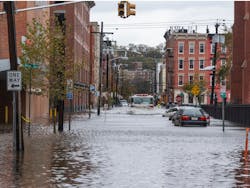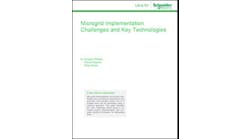New Jersey regulators approved several actions this week to promote advanced microgrids, including piloting ‘town center’ projects and establishing new funding and financing.
The iconic half house of Union Beach, New Jersey after Superstorm Sandy. By Sky Cinema/Shutterstock.com
In doing so, New Jersey joins several other states working to craft a way forward for the young microgrid industry, which faces older regulations that fail to contemplate the technology, so inadvertently block it.An in-depth report by the staff of the Board of Public Utilities (BPU) explained the problem by drawing an analogy between the microgrid and the cell phone.
“Without changing the energy regulatory structure, New Jersey could be trying to pay for a landline infrastructure in a cell phone world. An available option could be to determine that there will be no advanced microgrids in New Jersey. But given the cost trends and technology advances, that is not a realistic approach,” said the staff microgrid report, which the BPU voted to accept on Wednesday.
To bring the state into the ‘cell phone’ era for electricity, the BPU approved several actions, including development of town center microgrids in each utility service territory hit hard by Superstorm Sandy. New Jersey defines a town center microgrid as a project that uses multiple distributed energy resources (DERs) and serves multiple critical customers, such as hospitals, police and water treatment facilities. They are similar to what New York calls community microgrids.
The first pilot projects will be in nine storm-vulnerable counties already identified by the Federal Emergency Management Agency. The state wants to expand the program to 12 counties not designated by FEMA as well.
In preparing the report, the BPU staff drew from several sources, worked with stakeholders and explored efforts to pave the way for advanced microgrids in other states, such as New York and California and Connecticut.
“What we found is a budding of ideas and ways to make it possible,” the report said.
The report takes on some of the more difficult questions plaguing the development of advanced microgrids, including funding, financing and fair payment for microgrid services.
For example, the board plans to create incentives to pay for town center microgrid feasibility studies, a high-risk project phase.
“Assisting project development at this point can result in a high return on a small investment,” said the report.
The BPU also will look at developing a microgrid financing program, possibly through green banks, energy bonds, portfolio certificates or utility structures. And it intends to review state funds for distributed energy resources to determine if changes need to be made to suit microgrid development.
The report explores how to handle the problem of a town center microgrid crossing a utility right-of-way to reach customers – which in most states is not legal.
While the problems remains unresolved for New Jersey, the report explains a solution provided by microgrid advocates. A private developer would build the microgrid at its own expense, including any wires that cross a right-of-way to reach customers. The wires would connect to the grid under the utility’s specifications. Once construction was complete, the developer would turn over to the utility the wires portion that runs over the right-of-way. The utility would maintain the wires and be paid for the service via a special microgrid tariff.
The concept of the town center microgrid is relatively new. But microgrids, in general, are somewhat familiar in New Jersey.
The state already has about 50 operating microgrids, along with several pilot projects in various stages of developing advanced microgrids, including: New Jersey Transit Grid, Hoboken Microgrid, Trenton District Thermal Energy Complex and Atlantic City Mid-Town Thermal Facility.
The report highlighted the Princeton University microgrid as an example of the economic value advanced microgrids offer.
The microgrid kept power flowing to the campus while grid power was down for a week after Superstorm Sandy. “This saved the university millions in avoided losses of irreplaceable research projects,” the report said.
Beyond outages, Princeton’s facility also offers an example of how to manage microgrid economics under “blue sky conditions,” the report said.
Under these normal conditions, the microgrid leverages its own resources against the market. When the cost for grid electricity is high, the Princeton microgrid relies more on its on-site generation. When the price for electricity is low, the campus uses less on-site electricity and purchases more electricity from the grid.
“This is the same economic model that most advanced microgrids will need to follow in order to be cost effective,” the report said.
The Princeton microgrid benefits not only the campus, but also society. The college uses its energy storage system to reduce peak demand on the grid. As a result, the microgrid helps defray the cost of the local utility building new power plants and infrastructure.
Princeton provides this societal benefit, but receives little or no compensation for it.
“While they appropriately pay for the benefit of being connected to the grid, they do not see the full monetary value of the benefits they provide to the grid directly,” the report said.
As more advanced microgrids are added to the system, they will be in a similar situation – providing services without full compensation.
To resolve this inequity, the report recommended use of a distributed energy tariff, a “mechanism to balance these costs and benefits of the advanced microgrid. “The advanced microgrid should pay for the cost of using the grid and likewise should be paid for the benefits to the grid it provides.”
Town center microgrids could bring to New Jersey not only electric reliability and resiliency, but also greater energy efficiency, cleaner energy, less air emissions and cost savings, according to the report.
Superstorm Sandy flooded Hoboken, NJ. streets. Photo by Brian Derr/Shutterstock.com
Action is necessary now, the report said, given that customer demand for distributed energy is likely to rise as it becomes more efficient and less costly.
“The current utility grid model will not be able to adequately respond to the requests by customers to be ‘disconnected’ from the grid,” the report said. “It is better to help shape this change and what the future utility model should be in a more DER centric model as opposed to having to manage that utility business model in the middle of the actual change.”
The BPU microgrid report is available on the board’s website.
Join the Microgrid Knowledge LinkedIn group and share your thoughts about New Jersey’s microgrid plan.







